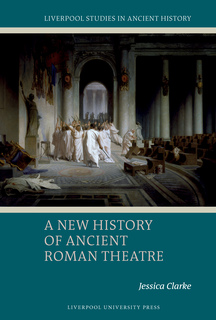A New History of Ancient Roman Theatre: Appendix B
Jessica Clarke
‘Roman theatre’ is a term often used to describe the theatre of ancient Italy during the second and third century BCE. Plautus and Terence are referred to as ‘Roman playwrights,’ and Rome itself is generally regarded as the driving force behind the development of theatrical culture in Italy. But was this early theatre in Italy specifically or characteristically Roman? Using previously marginalised archaeological source material and placing it in constructive dialogue with the surviving ancient literature, this book offers a significant reinterpretation of how theatre developed in the Italian peninsula, as well as a radical reappraisal of the role of Republican Rome as the impetus for cultural change. Challenging a long-held scholarly consensus, it is argued that whilst Rome would eventually rise to political and cultural dominance, the archaeological evidence does not encourage us to view Rome as a significant factor in the development of theatre in Italy until at least the end of the first century BCE and the construction of the Theatre of Pompey. Our attention is directed instead to other cities in the Italian peninsula during the third and second centuries BCE, which have hitherto been greatly overshadowed by imperialistic narratives of Roman cultural development.
The resource provided here is Appendix B, a comprehensive catalogue of all the comic visual material produced in or imported to the Italian peninsula between the end of the fourth century BCE and the middle of the first century CE. Due to the size of the dataset, it has not been produced in print and is available online here exclusively.
Appendix B
Appendix B is a comprehensive catalogue of all the extant comic visual material produced in or imported to the Italian peninsula between c. 325 BCE and 50 CE. This includes any visual representations of performances, performers, and the accoutrements of performance (such as masks), represented on decorative, architectural, or functional objects.
The basis for this dataset is the third edition of Monuments Illustrating New Comedy, originally produced by T. B. L. Webster and substantially revised and updated by John Green and Axel Seeberg in 1995.
The new digital database available here has extracted relevant material from Monuments Illustrating New Comedy and substantially revised, renumbered, and reordered the entries, as well as adding a significant number of new objects. The result is a dataset of 928 artefacts, including 76 previously uncatalogued objects.
The objects have been grouped into four temporal categories (c. 325 – 250 BCE, 250 – 150 BCE, 150 – 50 BCE, 50 BCE – 50 CE) and five geographic categories (Sicily, South Italy, Campania, Central Italy, and North Italy). For further definition and exploration of these categories, please see the Introduction of A New History of Ancient Roman Theatre.
Metadata
- publisherLiverpool University Press
- publisher placeLiverpool


